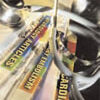Hurricane Katrina: Tragedy and Hope
My mind has been very much on New Orleans and the Gulf Coast the past couple of weeks. The utter devastation wrought by Hurricane Katrina, and the horrific images of stranded people clinging to rooftops, are shocking. Sitting in San Francisco it was hard to imagine just how terrifying and chaotic it could be.
What a different image than the one I had during my first visit to New Orleans in 1999 for the 2nd Annual Meeting of the National Association of Inpatient Physicians. I remember being enchanted by New Orleans and thinking how it seemed more European than American and the most foreign of any American city I had visited.
I brought my family to the meeting, and we had a wonderful visit. We stayed near the convention center and enjoyed strolling the streets of the French Quarter, eating beignets, and riding the streetcar. I had an unforgettable dinner at Emeril’s that still ranks among the finest I’ve ever had. These memories are completely at odds with the images in the newspaper and on television. Some of the most vivid stories I read of Hurricane Katrina were e-mails from hospitalists on the ground in New Orleans and from others helping to care for sick patients evacuated from hospitals in Louisiana.
The first-hand accounts from hospitalists in New Orleans were gripping. I read the now-familiar stories of trying to live in a city with no electricity, no safe drinking water, no sewer system, and no government. I read of one physician entering a darkened pharmacy under police escort so that he could gather life-saving medicines for people whose prescriptions were destroyed along with their homes. Steve Deitzelsweig, MD, FACP, a hospitalist at Ochsner Clinic in New Orleans described the fear of epidemics in the Wall Street Journal, as well as in The Hospitalist (see October, p. 1). The possibility of a typhoid outbreak in 21st century America seemed more like a plot from a bad movie than a headline in a major newspaper. Even hospitalists far from New Orleans enlisted in aiding evacuees.
E-mail dispatches from Pat Cawley, MD, in South Carolina and others described hospitalists helping care for the sick airlifted from Louisiana, Mississippi, and Alabama. Jeanne Huddleston, MD, SHM’s immediate past president, described her role leading a team of doctors from Mayo Clinic who went to Louisiana to care for the sick and injured.
Perhaps the most frightening images were of doctors and nurses caring for critically ill patients without the help of monitors, ventilators, or other equipment when the emergency power went out. The images of patients waiting for helicopters to airlift them to safety were harrowing. Also striking were reports from hospitalists whose families had been evacuated, their homes destroyed—and they were at the hospital caring for those who were sick prior to and because of the hurricane.
My gratitude and admiration go out to all of the doctors, nurses, respiratory therapists, pharmacists, social workers, chaplains, and others in the hurricane-devastated regions and elsewhere who worked so valiantly to help patients in the face of chaos. As president of SHM I am proud of the efforts of our members and of all hospitalists who continue to assist in the face of this tragedy.
The medical crisis caused by Hurricane Katrina is perhaps most noteworthy because it happened in America. Of course, physicians and nurses struggle to help their patients under similar or worse conditions every day across the world without the ability to airlift their patients anywhere. Nonetheless, to watch this happen in New Orleans was shocking and offered insights into what it must be like in war zones and the developing world.



